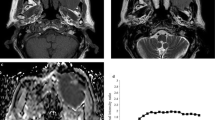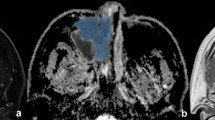Abstract
Purpose
This study aimed to investigate the feasibility of diffusion-weighted imaging (DWI) in combination with conventional MRI features to differentiate sinonasal malignant melanoma (SNMM) from sinonasal squamous cell carcinoma (SNSCC).
Methods
A total of 37 patients with SNMM and 44 patients with SNSCC were retrospectively reviewed. Conventional MRI features and apparent diffusion coefficients (ADCs) were evaluated independently by two experienced head and neck radiologists. ADCs were obtained from two different regions of interest (ROIs) including maximum slice (MS) and small solid sample (SSS). Multivariate logistic regression analysis was performed to identify significant MR imaging features in discriminating between SNMM and SNSCC. Receiver operating characteristic (ROC) curves were used to assess the diagnostic performance.
Results
SNMMs were more frequently located in the nasal cavity, with well-defined border, T1 Septate Pattern (T1-SP) and heterogeneous T1 hyperintensity, whereas SNSCCs were more frequently located in the paranasal sinus, with homogenous T1 isointensity, ill-defined border, reticular or linear T2 hyperintensity, and pterygopalatine fossa or orbital involvement (all p < 0.05). The mean ADCs of SNMM (MS ADC, 0.85 × 10−3mm2/s; SSS ADC, 0.69 × 10−3mm2/s) were significantly lower than those of SNSCC (MS ADC, 1.05 × 10−3mm2/s; SSS ADC, 0.82 × 10−3mm2/s) (p < 0.05). With a combination of location, T1 signal intensity, reticular or linear T2 hyperintensity, and a cut-off MS ADC of 0.87 × 10−3mm2/s, the sensitivity, specificity, and AUC were 97.3%, 68.2%, and 0.89, respectively.
Conclusion
DWI combined with conventional MRI can effectively improve the diagnostic performance in differentiating SNMM from SNSCC.




Similar content being viewed by others
Data availability
The processed data required to reproduce these findings cannot be shared at this time as the data also forms part of an ongoing study.
References
Moreno MA, Roberts DB, Kupferman ME, DeMonte F, El-Naggar AK, Williams M, Rosenthal DS, Hanna EY (2010) Mucosal melanoma of the nose and paranasal sinuses, a contemporary experience from the M. D. Anderson Cancer Center. Cancer 116:2215–2223
Yde SS, Sjoegren P, Heje M, Stolle LB (2018) Mucosal melanoma: a literature review. Curr Oncol Rep 20:28
Lund VJ, Howard DJ, Harding L, Wei WI (1999) Management options and survival in malignant melanoma of the sinonasal mucosa. Laryngoscope 109:208–211
Ganti A, Raman A, Shay A, Kuhar HN, Auger SR, Patel T, Kuan EC, Diaz AZ, Batra PS, Tajudeen BA (2019) Treatment modalities in sinonasal mucosal melanoma: a national cancer database analysis. Laryngoscope 130:275–282
Tacastacas JD, Bray J, Cohen YK, Arbesman J, Kim J, Koon HB, Honda K, Cooper KD, Gerstenblith MR (2014) Update on primary mucosal melanoma. J Am Acad Dermatol 71:366–375
Tajudeen BA, Vorasubin N, Sanaiha Y, Palma-Diaz MF, Suh JD, Wang MB (2014) Sinonasal mucosal melanoma: 20-year experience at a tertiary referral center. Int Forum Allergy Rhinol 4:592–597
Moreno MA, Hanna EY (2010) Management of mucosal melanomas of the head and neck: did we make any progress? Curr Opin Otolaryngol Head Neck Surg 18:101–106
Wehbe J, Jaikaransingh D, Walker A (2022) Immunotherapy as a treatment modality for mucosal melanoma of the head and neck: a systematic review. Medicine (Baltimore) 101:e29979
Hirakawa H, Hanai N, Ozawa T, Suzuki H, Nishikawa D, Matayoshi S, Suzuki M, Hasegawa Y (2016) Prognostic impact of pathological response to neoadjuvant chemotherapy followed by definitive surgery in sinonasal squamous cell carcinoma. Head Neck 38(Suppl 1):E1305–E1311
Ferrari M, Taboni S, Carobbio ALC, Emanuelli E, Maroldi R, Bossi P, Nicolai P (2021) Sinonasal squamous cell carcinoma, a narrative reappraisal of the current evidence. Cancers (Basel) 13:2835
Kim SH (2017) Mucosal malignant melanoma presenting with huge, fleshy, dark-red polyp in the nasal cavity. Br J Hosp Med (Lond) 78:297
Prasad ML (2007) Update on pigmented lesions of the sinonasal tract. Head Neck Pathol 1:50–54
Xu QG, Fu LP, Wang ZC, Xian JF, He LY, Zhang ZY, Liu CY (2012) Characteristic findings of malignant melanoma in the sinonasal cavity on magnetic resonance imaging. Chin Med J (Engl) 125:3687–3691
Wong VK, Lubner MG, Menias CO, Mellnick VM, Kennedy TA, Bhalla S, Pickhardt PJ (2017) Clinical and imaging features of noncutaneous melanoma. AJR Am J Roentgenol 208:942–959
Kim SS, Han MH, Kim JE, Lee CH, Chung HW, Lee JS, Chang KH (2000) Malignant melanoma of the sinonasal cavity: explanation of magnetic resonance signal intensities with histopathologic characteristics. Am J Otolaryngol 21:366–378
Kondziolka D, Bernstein M, Resch L, Tator CH, Fleming JF, Vanderlinden RG, Schutz H (1987) Significance of hemorrhage into brain tumors: clinicopathological study. J Neurosurg 67:852–857
Kawaguchi M, Kato H, Tomita H, Mizuta K, Aoki M, Hara A, Matsuo M (2017) Imaging characteristics of malignant sinonasal tumors. J Clin Med 6:116
Razek AA, Sieza S, Maha B (2009) Assessment of nasal and paranasal sinus masses by diffusion-weighted MR imaging. J Neuroradiol 36:206–211
Jiang JX, Tang ZH, Zhong YF, Qiang JW (2017) Diffusion kurtosis imaging for differentiating between the benign and malignant sinonasal lesions. J Magn Reson Imaging 45:1446–1454
Kim YK, Choi JW, Kim HJ, Kim HY, Park GM, Ko YH, Cha J, Kim ST (2018) Melanoma of the sinonasal tract: value of a septate pattern on precontrast T1-weighted MR imaging. AJNR Am J Neuroradiol 39:762–767
Kawaguchi M, Kato H, Tomita H, Hara A, Suzui N, Miyazaki T, Matsuyama K, Seishima M, Matsuo M (2020) MR imaging findings for differentiating cutaneous malignant melanoma from squamous cell carcinoma. Eur J Radiol 132:109212
Green B, Elhamshary A, Gomez R, Rahimi S, Brennan PA (2017) An update on the current management of head and neck mucosal melanoma. J Oral Pathol Med 46:475–479
Geninatti CS, Alberti D, Szabo I, Aime S, Djanashvili K (2013) MRI visualization of melanoma cells by targeting overexpressed sialic acid with a Gd(III)-dota-en-pba imaging reporter. Angew Chem Int Ed Engl 52:1161–1164
Jangard M, Hansson J, Ragnarsson-Olding B (2013) Primary sinonasal malignant melanoma: a nationwide study of the Swedish population, 1960–2000. Rhinology 51:22–30
Miracle AC, El Sayed IH, Glastonbury CM (2019) Diffusion weighted imaging of esthesioneuroblastoma: differentiation from other sinonasal masses. Head Neck 41:1161–1164
Maeda M, Kato H, Sakuma H, Maier SE, Takeda K (2005) Usefulness of the apparent diffusion coefficient in line scan diffusion-weighted imaging for distinguishing between squamous cell carcinomas and malignant lymphomas of the head and neck. AJNR Am J Neuroradiol 26:1186–1192
Wang X, Zhang Z, Chen Q, Li J, Xian J (2014) Effectiveness of 3 T PROPELLER DUO diffusion-weighted MRI in differentiating sinonasal lymphomas and carcinomas. Clin Radiol 69:1149–1156
Acknowledgements
We kindly thank Dr. Zheng Li from Beijing Tongren Hospital, Capital Medical University, for the revision of this manuscript and language polishing.
Funding
Beijing Municipal Administration of Hospitals' Ascent Plan [Code: DFL20190203]. Beijing Municipal Administration of Hospitals Clinical Medicine Development of Special Funding Support [Code: ZYLX201704].
Author information
Authors and Affiliations
Contributions
Hangzhi Liu, M.D., was responsible for measurements and statistical analyses of patient data and writing of original draft. Junfang Xian, Ph.D., was responsible for formulation of overarching research goals, acquisition of the financial support for the project leading to this publication, and leadership responsibility for the research. Xinyan Wang, M.D., and Mingyue Su, M.D., were responsible for collections of clinical and imaging data. Ning Wang, M.D., was responsible for collections of measurements of data.
Corresponding author
Ethics declarations
Competing interests
We declare that we have no conflict of interest.
Ethics approval
All procedures performed in studies involving human participants were in accordance with the ethical standards of the institutional and/or national research committee and with the 1964 Helsinki declaration and its later amendments or comparable ethical standards.
Consent to participate
Written informed consent was waived because of the retrospective nature of the study.
Consent for publication
Written informed consent for publication was obtained from all participants.
Additional information
Publisher's note
Springer Nature remains neutral with regard to jurisdictional claims in published maps and institutional affiliations.
Rights and permissions
Springer Nature or its licensor (e.g. a society or other partner) holds exclusive rights to this article under a publishing agreement with the author(s) or other rightsholder(s); author self-archiving of the accepted manuscript version of this article is solely governed by the terms of such publishing agreement and applicable law.
About this article
Cite this article
Liu, H., Wang, X., Su, M. et al. Differentiating sinonasal malignant melanoma from squamous cell carcinoma using DWI combined with conventional MRI. Neuroradiology 65, 1263–1270 (2023). https://doi.org/10.1007/s00234-023-03164-3
Received:
Accepted:
Published:
Issue Date:
DOI: https://doi.org/10.1007/s00234-023-03164-3




